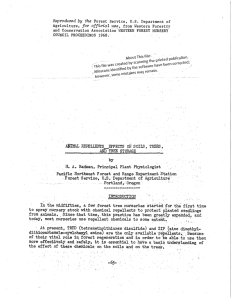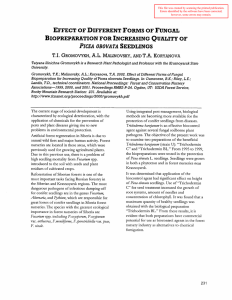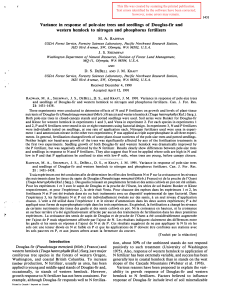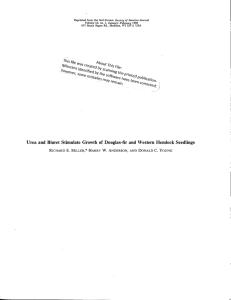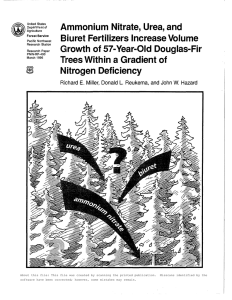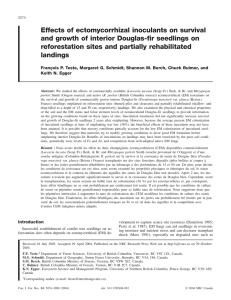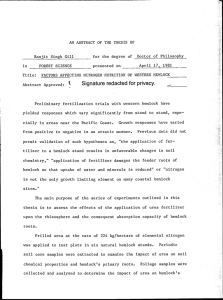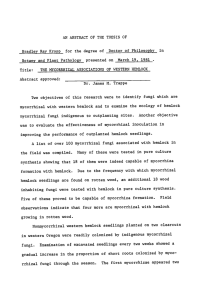Document 12787259
advertisement
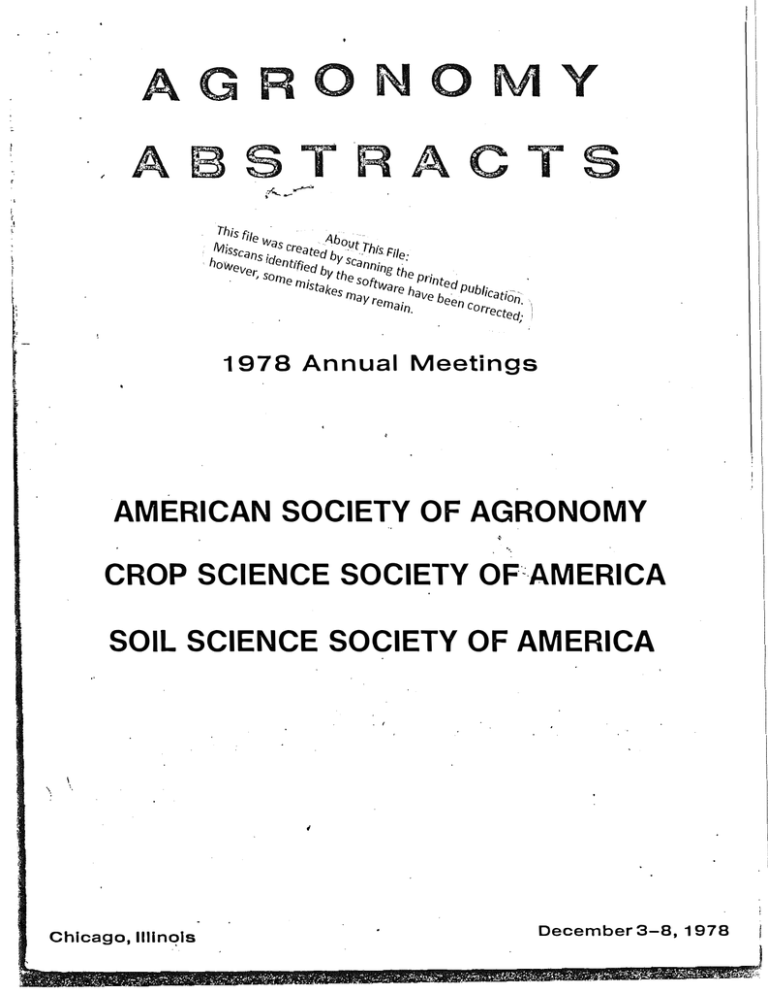
ONOMY AG
; ABSTRACTS ,
'hi s
file 'A,
Ab O'-, ""
v v as
-',
Ut I h
erea
, I'S
sSe ::>
ted b
'Ie:
- FI
'
"
411side ,
y se
a
hOW
nt
n
.
lfj'ed
ni
elle
n
g
b
t
th e
r, Sorn
Y he
S
'
Ptlnt
' ed
e rni
llv
Of
k
t
.
sta
a
P
r
e
bl
es rn
U iea -·
halle
tion"
ay r e
be.e
rnai
n e or
n,
reet d
e ,' i
.
I1\",
VI, ',
1978 Annual Meetings
AMERICAN SOCIETY OF AGRONOMY
CROP SCIENCE SOCIETY OF' -AMERICA
SOIL SCIENCE SOCIETY OF AMERICA
.
'\
,
\,
,
Chicago, IlIInC?ls
December 3-8, 1978
Soil
Sclenc{l Divisions
191
Impact of a Picloram Herbicide on Microbiological Processes, Nutrient Flux, and Water Quality in a Southern Appalachian
E.R. Madej *, D.G. Neary, R . L. Todd, and J.E. Douglass, USDA-USFS, Univ. of Georgia, Institute of Ecology.
,
A 4 ha portion of a scrub hardwood-rhododendron stand on watershed 19, Coweeta Hydrologic Lab, Franklin,
North Carolina, was treated with 50 kg/ha of Tordon 10K, in order to test its effectiveness as a site preparation
.Forest.
agent, and to evaluate its effect on forest soil processes.
The herbicide was applied in a pelletized form by
hand in May, 1978.
The application area was instrumented with 24 porous cup lysimeters placed at three different
depths.
A control area adjacent to the treated area was similarly instrumented with 12 lysimeters.
Preliminary
soil respiration, decomposition, and movement of the herbicide and nutrients are
impacts on nitrification,
discussed.
urea and Biuret Stimulate Growth of Douglas-fir and Western Hemlock Seedlings.
USDA-FS and Washington Dept. of Natural Resources.
R.
E.
M iller * and R. W. Anderson,
Two experiments were conducted in a glasshouse to support or allay a concern that biuret in urea fertilizer may
reduce growth of Douglas-fir
(Pseudotsuga menziesii)
or western hemlock
of both species in 2-liter pots were treated with 0, 0.224,
(Tsuga heterophylla).
Newly germinated seedlings
2.24, or 22.4 kg/ha biuret in factorial combinations with 0,
The biuret was applied as a solution to either the soil or the foliage.
Four
84, or 168 kg/ha N as reagent-grade urea.
of the eight replicates were harvested after the first growing season; the remaining seedlings were retreated with the
original dosages and harvested after the next growing season.
(p <
with increasing biuret
dosage was 14%
more
0.003);
than that with no biuret.
N dosage (P < 0.003).
In both experiments, seedling dry weight increased linearly
averaged over all other factors, weight of seedlings treated with the highest biuret
Douglas-fir seedlings were heavier than hemlock,
especially at the highest
These results indicate that biuret is unlikely to reduce growth of seedlings of either species--and
probably of older stands under field conditions--even when heavily contaminated urea is applied at high dosage.
A. V. Mol Iitor*, and
Forest 5011 Variability on Northeastern Floodplains.
College of Environmental Science and Forestry, Syracuse.
A. L. Leaf, state University of New York
In a forest type classification study, floodplain areas In eastern New York and western Vermont were sampled for soil
properties and tree species composition.
On the bases of physiography and species composition, two site types were Iden­
tified for stratification of data:
(1) lateral accretion deposits and (2) vertical accretion deposits. Nested analyses
of variance of 13 surface and 13 subsurface sol I properties of these alluvial Entisols and Inceptisols shows that, of the
variables measured, all with the exception of surface soil K concentrations were significantly less variable within sample
plots than among plots and that surface reaction and P, and subsurface clay, bulk density, reaction, P and Ca were less
variable on plots within types than between types.
Four or fewer pits per plot were sufficient for estimating surface and
subsurface bulk density and reaction, whl Ie the remaining variables require more Intensive sampling.
Seasonal Patterns of Dry Weight and Nutrient Composition of Fertilized Jack Pine. l.D. Morrow, and V.R. Timmer*, Ontario
Ministry of Natural Resources and School of Forestry, lakehead University, Thunder Bay.
Dry weight, nutrient concentration and nutrient content of current and year-old needles from a 26 year-old jack
pine plantation were monitored during the first growing season after fertilization with factorial combination of N,P and
K. The seasonal pattern of N concentrations exhibited characteristic dilution of N in the early summer which was coinci­
dent with rapid needle elongation. A recovery of N concentration levels was evident later in the season when needle
growth stabilized. In contrast, the trend of N content of individual needles shows a more consistent pattern of a
sustained increase throughout the season. Current needle growth was significantly increased by N applications, but not
wi h P and K fertilization. N fertilization not only increased the composition of N in the old and new foliage, but also
ralsed the amount of P, K, Ca and Mg in the new foliage. A preliminary diagnosis o.f N deficiency was made.
Mycorrhizal Response of Conifer Seedlings to Medium Pretreatment, Fertilizer and Funga:l.<Inoculation.
J.
M. Trappe, and B.
Zak ;
Soil Sci ence Department,
K.
*
R. Munson ,
Oregon State University and USDA Forest Service, Pacific Northwest
Forest and Range Experiment Station.
A greenhouse experiment was conducted to determine how mycorrhiza formation of containerized Douglas-fir,
ponderosa
pine and western hemlock was affected by interaction of medium pretreatment, fertilizer level and species of mycorrhizal
fungi.
Pretreatments included straining vs. methyl bromide vs. untreated control.
Fungal species inclu ded Thelephora
Seedlings were grown·in Leach
terrestris vs. Pisolithus tinctorius vs. Hebeloma crustuliniforme vs. Laccaria laccata.
cell containers.
Results show that a greater number of ponderosa pine seedlings formed mycorrhiza than did Douglas-fir
and western hemlock.
treatments.
level.
Mycorrhiza formation was greater in the steam treatment' than in the methyl bromide or control
The low level of fertilization produced a greater percentage of mycorrhizal seedlings than did the
A greater percentage of seedlings were mycorrhizal with H. crustiliniforme than with
!. terrestris and!. tinctorius.
These results suggest that co
L.
laccata,
igh
followed by
ideration must be given to tree species, fertilizer
levels, medium pretreatment methods and fungal s pecies for optimum mycorrhiza formation in container seedling nurseries.
Fertilizing California Forests:
Nitrogen Changes in the Soil Solution.
Field experiments have been established at 25 locations t.hroughout California forest lands, covering a range of soils,
Treatments consist of fall
nitrogen fertilization as urea, crossed with brush removal in younger stands or thinning
in
older.
Soil solution was
Results su gesf that
sampled during the wet season at 15, 50, and 100 cm depths and analyzed for NR4 +' NOr and urea.
nitrification rstes are low in untreated plots, but .that rates incre'ase following fertilization in proportion to the
amount of urea applied.
Removal of competing vegetation, either brush or trees, promoted nitrification and facil­
itated nitrate movement through the soil profile.
Nitrste concentrations decreased with profile depth but increased
Ammonium con­
with time at the 50 and 100 cm depths as nitrate moved from upper horizons with the moisture flux.
centrations· increased with fertilization rate, but seldom to very high levels - probably because of rapid conversion
to nitrate.
Cluster and' Factor Analysis as Application Tools for Fores t Fertilization Studies.
C. M. Yonker, USDA, Forest Service and Colo. State Univ., Fort Collins, Colo.
I
I
I
I
i
I
I.
G. Nakamura,* and R. F. Powers, USDA-Forest Service
forest types and tree sizes, to determine growth response to nitrogen fertilization.
I,
W. W. Patton*, J. E. Cipra, and
Pedon description data were taken from fertilizer test plots on the Willamette National Forest 1n W estern Oregon.
Twenty pedon description variables that w ere thought to have some effect on fertilization response were chosen from a


